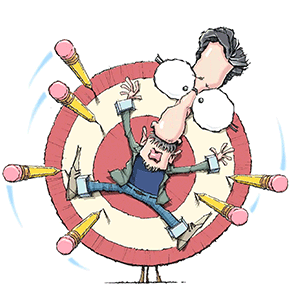Amid dangerous winds in 2011, LAFD engines stood ready. That didn't happen this time
Published in News & Features
LOS ANGELES — Thirteen years ago, Los Angeles Fire Department officials were bracing for the kind of dangerous winds that could drive flames across hillsides and canyons and tear through neighborhoods from Malibu to the Pacific Palisades to the San Fernando Valley.
The National Weather Service had issued red flag warnings of doomsday gusts as fierce as 90 miles per hour. Forecasters described the coming windstorm as a once in a five-to-10-year calamity.
So the LAFD began to marshal its defenses in the days before the arrival of the winds, taking the type of dramatic measures that the department failed to employ last week in advance of the Palisades fire, which followed wind alerts as bad or worse, due to the lack of recent rain, than those of late November 2011.
With the tempest expected to hit on Dec. 1 that year, LAFD commanders ordered up at least 40 extra fire engines for stations closest to the areas where the fire hazards were greatest, including the Palisades, The Times has learned through interviews and internal department records.
Among the additional rigs were more than 20 that were pre-deployed to those stations and 18 “ready reserve” engines that supplement the regular firefighting force in such emergencies, the records and interviews show.
“We could not take any chances on this, because the risk was too great,” said former LAFD Assistant Chief Patrick Butler, now chief of the Redondo Beach Fire Department, who led the agency’s preparations in 2011.
The LAFD commanders overseeing deployment before the Jan. 7 Palisades fire should have made similar preparations, Butler said.
“They underestimated the threat, even though the weather service had declared this a life-threatening wind event,” he said. “In my 35 years in the fire service, I have never heard the weather service use those words. It was a flashing danger sign.”
The weather service had advised that Jan. 7 and the next day could bring the strongest winds since that period in 2011. The warnings were even more dire because a lack of rain in recent months had left the wildlands particularly parched, said Ryan Kittell, a meteorologist for the weather service.
“The plants were extremely dry and the winds were extremely strong — it’s just the worst combination,” Kittell said.
As The Times reported last week, the LAFD decided not to tap several dozen available engines to join the fight against any fires fueled by the winds. A document obtained by The Times showed that commanders said “no” to deploying nine ready reserve engines to supplement nine other engines that had been pre-positioned the morning before the fire to the Valley and Hollywood.
Officials said they moved more engines “first thing in the morning” to cover northeast L.A. No extra engines were sent to the Palisades.
The department also opted against requiring a shift of about 1,000 firefighters to remain on duty rather than go home in the hours leading up to the fire. That decision made it more difficult to quickly staff the unused engines after the fire began to rage out of control, former LAFD chiefs told The Times.
Fire Chief Kristin Crowley and other top officials have defended their decisions, saying they had to juggle limited resources while continuing to handle 911 calls unrelated to the fire, which doubled the day it started, Jan. 7, because of wind damage elsewhere in the city. LAFD officials have also claimed that the firefighting effort was hampered by budget constraints and low water levels for some fire hydrants.
“We followed the system. We surged where we could surge,” Crowley said at a press conference on Wednesday. “Our firefighters pushed in, they did everything that they could.”
But the department faced those same challenges in 2011, and that did not stop commanders from devoting many more engines to the fire zones before the winds roared into the city, according to the records and interviews.
As it happened, the winds downed power lines and trees and caused other havoc, but they did not spark any wildfires. Butler said he considered his preparations in 2011 routine for such a frightening wind forecast, and that he had taken similar preemptive steps on about 30 other occasions during his years with the LAFD.
In most cases, no fires erupted, but Butler said commanders cannot gamble on that outcome. He cited long-standing LAFD directives requiring commanders to put in place whatever is needed to hit brush fires “hard and fast.”
Former LAFD Battalion Chief Rick Crawford told The Times that he would have taken the same approach to last week’s wind threat as Butler did in 2011. Crawford worked for the department for 33 years, including as a captain in the LAFD’s operations center, before leaving in 2024 for his current post as emergency and crisis management coordinator for the U.S. Capitol.
He said the department should have staffed at least 25 more engines the morning before the Palisades blaze and moved others to the potential fire zones. Recalling the outgoing shift of firefighters that day would have made more engine crews available, Crawford said.
“I would have been more offensive-minded,” he added.
Because of the punishing winds, he said, “you were going to have a major fire that day. But would it have been as deadly? Would it have been the most destructive in the history of Los Angeles? I don’t think so.
“Give yourself the best chance to minimize the damage.”
Crowley did not respond to an interview request for this story. She and a spokesperson also did not provide answers to a list of written questions from The Times about the LAFD’s preparations for and response to the Palisades fire.
When asked about the planning decisions at a news conference Wednesday, Mayor Karen Bass acknowledged that “the buck always stops with me,” but deferred questions to Crowley. Bass’ press office did not respond to an email requesting an interview with her for this story.
Deputy Chief Richard Fields, who was in charge of staffing and equipment decisions ahead of the Palisades fire, defended his plan for deployment as “appropriate for immediate response.” When asked about the more robust preparations in 2011, he said the department’s fleet of operable engines was larger back then.
“Today, I have zero reserve fleet,” Fields said. “Zero, because of the number of apparatus that we have in ill-repair.”
The Times found, however, that the department had a set of more than 40 engines that were available for crews, and officials chose to staff just five of them ahead of the fire.
Known internally as 200 Series engines, they are identical to other engines and placed around the city, usually paired with hook and ladder trucks, which do not carry water. In non-emergencies, they are staffed by a single engineer. When needed for wildfires, they carry four firefighters.
Crowley said that in a “perfect world,” she would have staffed the ready reserve engines, but budget cuts that eliminated half of the LAFD’s mechanic positions have left many inoperable.
But just two of the nine ready reserve engines listed on the planning document — the record in which officials said “no” to deploying them — were out of service and needed to be replaced, officials said. And seven were put into service at one point or another —most of them after the fire ignited. Some were pulled out of the maintenance shop.
Fire officials said that 40 out of a total of 195 engines at the LAFD were broken at the time of the Palisades fire. Had they been repaired, they said, it could have made a difference.
That doesn’t account for why the department didn’t staff and deploy all of the 200 Series engines that were available, Butler and other former LAFD chiefs said.
“The engines that were in the shop do not play into what they could have done,” Butler said.
The Palisades fire has burned nearly 24,000 acres and destroyed more than 3,500 homes and other structures, officials estimate. At least 10 people have died in the fire, according to the Los Angeles County coroner’s office and Sheriff’s Department.
The Eaton fire, which started after the Palisades blaze in the Altadena area, has blackened more than 14,000 acres, destroyed about 9,000 homes and other structures, and killed 17 people, officials say.
“It’s important to draw a lesson from this and not repeat what happened,” Butler said of the command decisions. “Firefighters on the ground, I guarantee you, are giving 100 percent of their effort despite all these challenges.”
©2025 Los Angeles Times. Visit at latimes.com. Distributed by Tribune Content Agency, LLC.







Comments